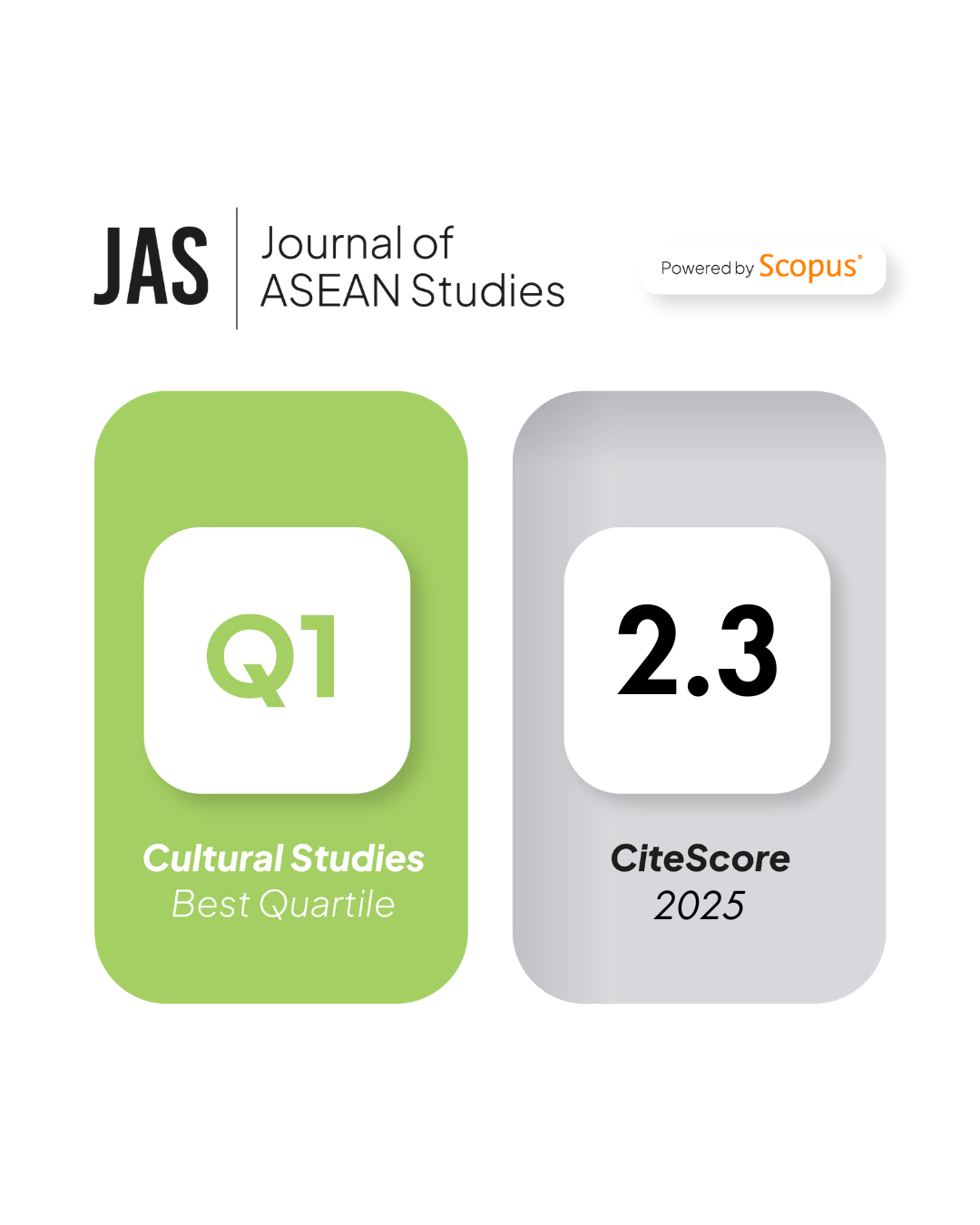What Caused the Ethnic Revival? Multi-case Studies in 11 Southeast Asian Countries
DOI:
https://doi.org/10.21512/jas.v13i1.10478Keywords:
ethnic conflict, ethnic revival, Southeast Asia, theory of justiceAbstract
Prolonged ethnic wars emerged due to disharmonious ethnic relations in Southeast Asian countries. Marginalized ethnic groups often create an ethnic revival in response to the dominance of other ethnic groups. The research analyzed the causes, processes, and ways to minimize ethnic revival in Southeast Asian countries. By using a multi-case study analysis, the results show that ethnic revival in Southeast Asia has similarities in terms of past conflict history passed down from generation to generation as well as the use of ethnic identity as a driving force of its movement. It also found that the cause of ethnic revival was the practice of injustice carried out by certain ethnic groups who dominated the government. Injustice then causes marginalized ethnic groups to use their ethnic identities to create ethnic sentiments, which are then used to form ethnic revival. Using Rawls' theory of justice, this research proposes three principles of justice: justice as fairness, principles of justice, and veil of ignorance that states must apply to create policies that are not ethnically biased.
References
Aapenguo, C.M. (2010, April 30). Misinterpreting ethnic conflicts in Africa. Africa Center For Strategic Studies. https://africacenter.org/publication/misinterpreting-ethnic-conflicts-in-africa/
Abaya, J. V. (2016). Globalization and the rise of ethnic conflict in Southeast Asia. The IAFOR International Conference on Global Studies 2016 Official Conference Proceedings.
Aguswandi & Zunzer, W. (2008, October 1). From politics to arms to politics again the transition of the Gerakan Aceh Merdeka (Free Aceh Movement - GAM). Berghof Foundation. https://berghof-foundation.org/library/from-politics-to-arms-to-politics-again-the-transition-of-the-gerakan-aceh-merdeka-free-aceh-movement-gam
Akpan, W. (2008). Ethnic diversity and conflict in Nigeria : Lessons from the Niger Delta crisis. African Journal on Conflict Resolution, 8(1), 161–191. http://dx.doi.org/10.4314/ajcr.v8i1.39414
Alubo, O. (2009). Citizenship and identity politics in Nigeria. Conference Proceedings on Citizenship and Identity Politics in Nigeria.
Alusala, N. (2005). Disarmament and reconciliation : Rwanda's concerns. Institute for Security Studies Papers, 2005(108), 1-16.
Anwary, A. (2020). Interethnic conflict and genocide in Myanmar. Homicide Studies, 24(1), 85–102. https://doi.org/10.1177/1088767919827354
Aphornsuvan, T. (2007). Rebellion in Southern Thailand: Contending histories. East-West Center.
Appadurai, A. (1998). Dead certainty ethnic violence in the era of globalization. Development and Change, 29(4), 905–925. https://doi.org/10.1111/1467-7660.00103
Arcan, H.E. (2014). Ethnic identities and conflict: Ethnic conflict prevention approach of European Union. Journal of Educational and Social Research, 4(1), 27–38.
Arthur, C. (2018). From Fretilin to freedom: The evolution of the symbolism of Timor-Leste’s National flag. Journal of Southeast Asian Studies, 49(2), 227–249.
Audard, C. (2024). Addressing the rise of inequalities: How relevant is Rawls’s critique of welfare state capitalism? Journal of Social Philosophy, 55(2), 221–237. https://doi.org/10.1111/josp.12517
Barbero, J.M. (2002). The city: Between fear and the media. In S. Rotker (Ed.), Citizens of fear: Urban violence in Latin America (pp. 25-36). Rutgers University Press.
Barth, F. (1998). Ethnic groups and boundaries: The social organization of culture difference. Waveland Press.
Baxter, P. & Jack, S. (2015). Qualitative case study methodology: Study design and implementation for novice researchers. The Qualitative Report, 13(4), 544–559. https://doi.org/10.46743/2160-3715/2008.1573
Bhakti, I.N. (2005). A new kind of self-determination in Papua: The choice between independence and autonomy. In D. F. Anwar, H. Bouvier, G. Smith, & R. Tol (Eds.),Violent internal conflicts in Asia Pacific: Histories, political economies, and policies. Yayasan Obor Indonesia.
Brown, D. (2003). The state and ethnic politics in SouthEast Asia. Routledge.
Buchanan, J. (2016). Militias in Myanmar. The Asia Foundation. https://asiafoundation.org/wp-content/uploads/2016/07/Militias-in-Myanmar.pdf
Buendia, R. G. (2005). The state‐Moro armed conflict in the Philippines Unresolved national question or question of governance? Asian Journal of Political Science, 13(1), 109–138. https://doi.org/10.1080/02185370508434252
Case, W. (1994). The UMNO party election in Malaysia: One for the money. Asian Survey, 34(10), 916–930.
Caspersen, N. F. (2006). Intra-ethnic competition and inter-ethnic conflict : Serb elites in Croatia and Bosnia 1990-1995 [PhD Thesis]. University of London.
Chan, S. (2004). Survivors : Cambodian refugees in the United States. University of Illinois Press.
Chandler, D. P. (2000). A history of Cambodia (3rd Edn.) Westview Press, Inc.
Chandra, K. (2006). What is ethnic identity and does it matter? Annual Review of Political Science, 9, 397–424. https://doi.org/10.1146/annurev.polisci.9.062404.170715
Cheng, A. L. H. (2001). The past in the present: Memories of the 1964 “Racial Riots” in Singapore. Asian Journal of Social Science, 29(3), 431–455.
Chua, A. (2004). World on fire: How exporting free market democracy breeds ethnic hatred and global instability. Anchor Books.
Clutterbuck, R. L. (1985). Conflict and violence in Singapore and Malaysia 1945-1983. Routledge.
Collier, P. & Hoeffler, A. (2004). Greed and grievance in civil war. Oxford Economic Papers, 56(4), 563–595.
Cook, M. & Collier, K. 2006. Mindanao: A gamble worth taking. Lowy Institute.
Core, P. (2009). Burma/Myanmar: Challenges of a ceasefire accord in Karen State. Journal of Current Southeast Asian Affairs, 28(3), 95–105. https://doi.org/10.1177/1868103409028003
Creswell, J. W. (2013). Qualitative inquiry and research design: Choosing among five approaches (3rd ed.). SAGE Publications.
Daniels, N. (2001). Justice, health, and healthcare. American Journal of Bioethics, 1(2), 2–16. https://doi.org/10.1162/152651601300168834
Davis, S. L. M. (2005). Song and silence: Ethnic revival on China’s Southwest borders. Columbia University Press.
De Coninck, T., & Van De Putte, F. (2023). Original position arguments and social choice under ignorance. Theory and Decision, 94(2), 275–298. https://doi.org/10.1007/s11238-022-09889-6
Doan, T. T. (2017). Physical and theoretical notions of home: In the Context of Khmer Krom in Soc Trang and Can Tho, Vietnam. International Development, Community and Environment (IDCE) 151.
Dunlop, E. (2021). Ethnicity, exclusion, and exams: Education policy and politics in Burundi from the Independent Republics to the Civil War (1966–1993). Africa Spectrum, 56(2), 151–171. https://doi.org/10.1177/00020397211023513
Ecip, S. S. (2002). Rusuh Poso Rujuk Malino. Cahaya Timur.
Edor, E. J. (2020). John Rawls’s concept of justice as fairness. PINISI Discretion Review, 4(1), 179-190. https://doi.org/10.26858/pdr.v4i1.16387
Eriksen, T.H. (2015). Small places, large issues : An introduction to social and cultural anthropology (4th ed.). Pluto Press.
Fanselow, F. (2014). The anthropology of the state and the state of anthropology in Brunei. Journal of Southeast Asian Studies, 45(1), 90–112. https://doi.org/10.1017/s0022463413000611
Fanton, M. (2020). Rawls’s point of view: A systematic reading of justice as fairness. Brazilian Political Science Review, 14(2). https://doi.org/10.1590/1981-3821202000020003
Furnivall, J. S. (2014). Colonial policy and practice. A comparative study of Burma and Netherlands India. Cambridge University Press.
Gahramanova, A. (2006). Identity conflict and its implications for conflict management. Revista UNISCI, 11, 153–186.
Goh, D. P. S. (2008). From colonial pluralism to postcolonial multiculturalism: Race, state formation and the question of cultural diversity in Malaysia and Singapore. Sociology Compass, 2(1), 232–252. https://doi.org/10.1111/j.1751-9020.2007.00065.x
Hinton, A. L. (2005). Why did they kill?: Cambodia in the shadow of genocide. University of California Press.
Ho, H. M. Y. (2021). Chinese Bruneian identity: Negotiating individual, familial and transnational selves in anglophone Bruneian literature. Wenshan Review of Literature and Culture, 14(2), 1–34.
Hooker, V. M. (2003). A short history of Malaysia: Linking East and West. Allen & Unwin.
Horowitz, D.L. (1985). Ethnic groups in conflict. University of California Press.
Huang, K., Greene, J. D. & Bazerman, M. (2019). Veil-of-ignorance reasoning favors the greater good. Proceedings of the National Academy of Sciences of the United States of America, 116(48), 23989–23995. https://doi.org/10.1073/pnas.1910125116
Huat, C.B. (2003). Multiculturalism in Singapore: An instrument of social control. Race & Class, 44(3), 58–77.
Human Right Watch. (2009, January 9). On the margins: Rights abuses of Ethnic Khmer in Vietnam’s Mekong Delta. Human Right Watch. Human Right Watch. https://www.hrw.org/report/2009/01/21/margins/rights-abuses-ethnic-khmer-vietnams-mekong-delta
Hutchison, B.G. (2009). Abu Sayyaf. [Counterproliferation Paper No. 49]. USAF Counterproliferation Center
Iacovou, C. (2000). From MNLF to Abu Sayyaf: The radicalization of Islam in the Philippines. The International Policy Institute for Counter Terrorism.
Imbong, R.A. (2018). Neoliberalism and the Moro struggle in Southern Philippines. Journal for the Study of Religions and Ideologies, 17(51), 69–84.
International Crisis Group. (2020, August 28). Identity crisis: Ethnicity and conflict in Myanmar. International Crisis Group. https://www.crisisgroup.org/asia/south-east-asia/myanmar/312-identity-crisis-ethnicity-and-conflict-myanmar
Jackson, R. (2005). Lifting the veil of ignorance: John Rawls’s society of peoples. In R. Jackson (Ed.). Classical and modern thought on international relations (pp. 157–179). Palgrave Macmillan US.
Jinadu, L.A. (2004). Explaining and managing ethnic conflict in Africa: Towards a cultural theory of democracy. African Journal of Political Science, 9(1), 1–26.
Jolliffe, K. (2016). Ceasefires, governance and development: The Karen National Union in times of change. The Asia Foundation.
Juliano, H.A., Ordońez, M.D.D. & Vińa, E.A.B. La. (2019). Dealing with diversity: State strategies on ethnic minority. Asian Review, 32(1), 85–108.
Kayagula, B.N. & Lameck, W. (2024). The application of Rawls ’ Theory of Justice in providing equitable free health services to geriatrics in Tanzania. Research Square. https://doi.org/10.21203/rs.3.rs-4823278/v1
Kim, H. (2010). International ethnic networks and Intra-Ethnic conflict: Koreans in China. Palgrave Macmillan.
King, V. T. (2001). A question of identity: Names, societies, and Ethnic Groups in Interior Kalimantan and Brunei Darussalam. Sojourn: Journal of Social Issues in Southeast Asia, 16(1), 1–36.
Koppelman, A. (2023). Rawls, inequality, and welfare-state capitalism. American Journal of Law and Equality, 3, 256–282. https://doi.org/10.1162/ajle_a_00057
Kumar, P. (2012). Malaysia: Majority supremacy and ethnic tensions. Institute of Peace and Conflict Studies.
Kyed, H.M. & Gravers, M. (2014). Non-state armed groups in the Myanmar Peace Process: What are the future options? (DIIS Working Paper No. 7). Danish Institute for International Studies
Lao Movement for Human Rights. (2005). Situation of the ethnic and religious minorities in the Lao People’s Democratic Republic.
Laoutides, C. (2021). Ethnoreligious conflict and populism: Emotive political response in the rohingya conflict. Religions, 12(10), 816. https://doi.org/10.3390/rel12100816
Lecomte-Tilouine, M. (2009). Hindu Kingship, Ethnic revival, and Maoist rebellion in Nepal. Oxford University Press.
Lecomte-Tilouine, M. & Dollfus, P. (2003). Ethnic revival and religious turmoil : Identities and Representations in the Himalayas. Oxford University Press.
Lewis, A. (2015). Historical patterns of the racialisation of Vietnamese in Cambodia, and their relevance today [CERS Working Paper 2015]. University of Leeds.
Lian, B. 2008. Evolving on-line empowerment: The Manchu identity revival since the 1980s. Maryland Series in Contemporary Asian Studies, 2008(4).
Liu, J. H., Lawrence, B., Ward, C. & Abraham, S. (2002). Social representations of history in Malaysia and Singapore: On the relationship between national and ethnic identity. Asian Journal of Social Psychology, 5(1), 3–20.
Loo, S. P. (2009). Ethnicity and educational policies in Malaysia and Brunei Darussalam. SA-eDUC Journal, 6(2), 146–157.
Lum, T. (2010). Laos: Background and U.S. relations [CRS Report for Congress]. Congressional Research Service.
Madale, N. T. & Medina, N. A. (2004). The Mindanao conflict and prospects for Peace in the Southern Philippines. https://www.niu.edu/clas/cseas/_pdf/lesson-plans/topical-overviews/mindanao-peace.pdf
Mamdani, M. (2009). Making sense of political violence in Postcolonial Africa. In L. Panitch, & C. Leys (Eds.), Fighting identities: Race, religion, and ethno-nationalism (pp. 132-151).
Manzano, J. A. F. (2018). Beyond Rawls’ basic structure of society. In E. Etieyibo (Ed.), Perspectives in social contract theory (pp. 139–153). The Council for Research in Values and Philosophy.
McHale, S. (2013). Ethnicity, violence, and Khmer-Vietnamese relations: The significance of the lower Mekong Delta, 1757-1954. Journal of Asian Studies, 72(2), 367–390.
Melvin, N. J. (2007). Conflict in Southern Thailand: Islamism, violence and the State in the Patani insurgency [SIPRI Policy Paper No. 20]. Stockholm International Peace Research Institute
Miller, M. A. (2011). Introduction – Ethnic minorities in Asia: Inclusion or exclusion? Ethnic and Racial Studies, 34(5), 751–761. https://doi.org/10.1080/01419870.2010.537361
Miller, R. W. (2011). Rawls and global justice: A dispute over a legacy. The Monist, 94(4), 466–488.
Montiel, C. J., Rodil, R. B. & de Guzman, J. M. (2012). The Moro struggle and the challenge to peace building in Mindanao, Southern Philippines. In D. Landis, & R. D. Albert (Eds.), Handbook of ethnic conflict: International perspectives (pp. 71–89). Springer US.
Mwiza, T. & Okinedo, E. 2018. Global political studies international migration and ethnic relations impacts of colonialism in Africa : A case study of Ethnic Identity and Ethnic Conflicts in Burundi [Bachelor Thesis]. Malmo University.
Narayan, R. (2000). The East Timor crisis. China Report, 36(1), 93-99. https://doi.org/10.1177/000944550003600107
Neupert, R.F. & Prum, V. (2005). Cambodia: Reconstructing the demographic stab of the past and forecasting the demographic scar of the future. European Journal of Population/Revue Européenne de Démographie, 21(2), 217–246. https://doi.org/10.1007/s10680-005-6854-3
Niksih, L. A. (2007). Abu Sayyaf: Target of Philippine-U.S. Anti-Terrorism Cooperation [CRS Report For Congress]. Library of Congress. Congressional Research Service.
Nurhadiantomo. (2004). Hukum reintegrasi sosial: Konflik-konflik sosial pri-non pri dan hukum keadilan sosial. Muhammadiyah University Press
Nurhasim, M. (2008). Konflik dan integrasi politik Gerakan Aceh Merdeka: Kajian tentang konsensus normatif antara RI-GAM dalam Perundingan Helsinki. Pustaka Pelajar.
Ott, J. S. (1989). The organizational culture perspective. Dorsey Press.
Pattiradjawane, E.P. (2000). Peristiwa Mei 1998 di Jakarta: Titik terendah sejarah orang Etnis Cina di Indonesia. In I. Wibowo (Ed.), Harga yang harus dibayar: Sketsa pergulatan Etnis Cina di Indonesia. Gramedia Pustaka Utama.
Peterson, D. R. (2012). Ethnic patriotism and the East African revival: A History of Dissent, .1935–1972. Cambridge University Press.
Pilapil, R. D. (2019) . John Rawls and distributive justice in a globalizing world. Social Science Diliman, 15(1), 1-24.
Purwanto, W. H. (2007). Menggapai damai di Poso. CMB Press.
Rahman, M.A. (2004). Api dalam sekam: Studi analisa konflik Ambon Maluku. Komnas HAM.
Rawls, J. (1971). A theory of justice. Harvard University Press Cambridge.
Rocha, Z.L. (2011). Multiplicity within singularity: Racial categorization and recognizing “Mixed Race” in Singapore. Journal of Current Southeast Asian Affairs, 30(3), 95–131. https://doi.org/10.1177/186810341103000304
Rubin, B. R. (2006). Central Asia and Central Africa: Transnational wars and ehnic conflicts. Journal of Human Development, 7(1), 5–22. http://dx.doi.org/10.1080/14649880500501138
Ruger, J. P. (2004). Ethics of the social determinants of health. The Lancet, 364(9439), 1092–1097. https://doi.org/10.1016/S0140-6736(04)17067-0.
Saad, I. (1983). National culture and social transformation in contemporary Malaysia. Southeast Asian Journal of Social Science, 11(2), 59–69.
Saidi, M. A. & Oladimeji, T. (2015). Hutu-Tutsi conflict in Burundi: A critical exploration of factors. The International Journal of Humanities & Social Studies, 3(6), 298–304.
Sambanis, N. 2002. A review of recent advances and future directions in the quantitative literature on civil war. Defence and Peace Economics , 13(3), 215–243.
Osman, S. (1989). Ikatan etnik dan kelas di Malaysia. Universiti Kebangsaan Malaysia
Sari, C. M. A. (2018). The imagined community of Indonesia : Pertentangan nasionalisme Indonesia vs etnonasionalisme bangsa Aceh dalam Gerakan Aceh Merdeka (GAM). Al-Ijtimai International Journal of Goverment and Social Science, 3(2), 131–152.
Sari, C. M. A. (2020). Rawls’s theory of justice and its relevance in analyzing injustice on ethnic phenomenon. Journal of Ethnic and Cultural Studies, 7(3), 210–219. https://doi.org/10.29333/ejecs/497
Sari, C. M. A., @ Khalid, K. A. T. & Hamzah, S. A. (2022). From “Song of War” to “Song of Peace”: The role of Hikayat Prang Sabi for Acehnese Ethnonationalism. Cogent Arts & Humanities, 9(1). https://doi.org/10.1080/23311983.2022.2062894
Sari, C. M. A., Hasan, E., Syahbandir, M. & Efendi, E. (2019). The internalisation process and pattern on ideology ethnonationalism from five leaders of the free aceh movement to their children. International Journal of Innovation, Creativity and Change, 7(8).
Sari, C. M. A. & Khalid, K. A. T. @. (2024). Transmigration, ethnic sentiment , and inter-ethnic conflict in Aceh. Akademika 94, (3), 300–316. https://doi.org/10.17576/akad-2024-9403-17
Sari, C.M.A., Khalid, K.A.T.@ & Hamzah, S.A. (2023). Aceh post-peace agreement : New conflicts and transactional politics. Akademika 93(2), 185–202. https://doi.org/10.17576/akad-2023-9302-15
Scambary, J. & Wassel, T. (2018). Hybrid peacebuilding in hybrid communities: A case study of East Timor. In J. Wallis, L. Kent, M. Forsyth, S. Dinnen, & S. Bose, Hybridity on the ground in peacebuilding and development (pp. 181–199). ANU Press.
Schlemmer, G. 2017. Ethnic belonging in Laos: A politico-historical perspective. In V. Boute, & V. Pholsena, Changing lives in Laos: Society, politics and culture in a post-socialist state (pp. 251-280). NUS Press.
Schuck, C. (2021). How Islamist is the Abu Sayyaf Group (ASG)? An ideological assessment. Asian Security, 17(1), 105–118. https://doi.org/10.1080/14799855.2020.1742700
Schutt, R. K. (2018). Investigating the social world: The process and practice of research. SAGE Publications.
Scupin, R. R. & DeCorse, C. R. (2015). Anthropology: A global perspective. Pearson Education.
Selth, A. (2018). Myanmar’s armed forces and the Rohingya crisis. United States Institute of Peace.
Sinaga, L.C. 2022. The problem of statelessness of the ethnic Chinese in Brunei Darussalam. In A. Khanif & K. Y. Hooi, Marginalisation and Human Rights in Southeast Asia (pp. 120-135). Taylor & Francis.
Singh, B. (2018). Crime-terror nexus in Southeast Asia: Case study of the Abu Sayyaf group. Counter Terrorist Trends and Analyses, 10(9): 6–10.
Singh, H. (2001). Ethnic conflict in Malaysia revisited. Commonwealth and Comparative Politics, 39(1), 42–65. https://doi.org/10.1080/713999532
Smith, A. D. (1981). The Ethnic Revival. Cambridge University Press.
Smith, A. D. (2001). Nationalism: Theory, ideology, history. Polity Press.
Soong, K. K. (2007). Racial conflict in Malaysia: Against the official history. Race & Class, 49(3), 33–53. https://doi.org/10.1177/0306396807085900
South, A. (2008). Ethnic politics in Burma: States of conflict (1st ed.). Routledge.
Srisompob, J. & Panyasak, S. (2006). Unpacking Thailand’s southern conflict: The poverty of structural explanations. Critical Asian Studies, 38(1), 95–117. https://doi.org/10.1080/14672710600556478
Sturesson, J. (2022). Rawls’s distributional justice in Swedish healthcare [Bachelor's Thesis]. Umeå University
Suryadinata, L. (2015). The making of Southeast Asian Nations: State, ethnicity, indigenism and citizenship. World Scientific Publishing. https://doi.org/10.1142/9218
Taylor, P. (2014a). The Khmer Lands of Vietnam: Environment, cosmology and sovereignty. NUS Press.
Taylor, P. (2014b). Coercive localization in Southwest Vietnam: Khmer Land disputes and the containment of dissent. Journal of Vietnamese Studies, 9(3), 55–90. https://doi.org/10.1525/vs.2014.9.3.55
Taylor, S. J., Bogdan, R. & DeVault, M. L. (2016). Introduction to qualitative research methods: A guidebook and resource (4th edn.). John Wiley & Sons, Inc.
Teh, H. H. W. (1983). Race relations in Malaysia. Heinemann Educational Books (Asia).
The Asia Foundation. (2017). The state of conflict and violence in Asia. The Asia Foundation.
Trijono, L. (2001). Keluar dari kemelut Maluku: Refleksi pengalaman praktis bekerja untuk perdamaian Maluku. Pustaka Pelajar.
Tsuchiya, K. (2021). Southeast Asian cultural landscape, resistance, and belonging in East Timor’s FRETILIN Movement (1974-75). Journal of Southeast Asian Studies, 52(3): 515-538. https://doi.org/10.1017/S0022463421000746
Tsuda, T. 2015. Recovering heritage and homeland: Ethnic revival among fourth-generation Japanese Americans. Sociological Inquiry, 85(4), 600–627. https://doi.org/10.1111/soin.12095
Ullah, A. K. M. & Kumpoh, A. A. Z. A. (2019). Diaspora community in Brunei: Culture, ethnicity and integration. Diaspora Studies, 12(1), 14–33. https://doi.org/10.1080/09739572.2018.1538686
van Klinken, G. (2001). The Maluku wars: Bringing society back in. Indonesia, 71, 1–26.
Vanhanen, T. (1999). Domestic ethnic conflict and ethnic nepotism: A comparative analysis. Journal of Peace Research, 36(1), 55–73. https://doi.org/10.1177/0022343399036001004
Varshney, A. (2002). Ethnic conflict and civic life: Hindus and Muslims in India. Yale University Press.
Vasil, R. (1995). Asianising Singapore: The PAP’s management of ethnicity. Heinemann Asia.
von Platz, J. (2017). Veil of Ignorance in Rawlsian Theory. In The SAGE encyclopedia of political behavior (vol. 2, pp. 890-892). SAGE Publications, Inc. https://doi.org/10.4135/9781483391144.n403
Walter, B. F. (2004). Does conflict beget conflict? Explaining recurring civil war. Journal of Peace Research, 41(3), 371–388. https://doi.org/10.1177/0022343304043775
Waters, M. C. (1990). Ethnic options: Choosing identities in America. University of California Press.
Wirth, L. (1945). The problem of minority groups. Columbia University Press.
Wolthuis, B. (2017). Principles of economic union: An extension of John Rawls’s theory of justice. European Law Journal, 23(6), 454–466. https://doi.org/10.1111/eulj.12265
Yin, R. K. (2009). Case study research: Design and methods. SAGE Publications.
Zimmer, Z., Knodel, J., Kim, K.S. & Puch, S. (2006). The impact of past conflicts and social disruption on the elderly in Cambodia. Population and Development Review, 32(2), 333–360. https://doi.org/10.1111/j.1728-4457.2006.00122.x
Downloads
Published
How to Cite
Issue
Section
License
Copyright (c) 2025 Cut Maya Aprita Sari, Kartini Aboo Talib @ Khalid

This work is licensed under a Creative Commons Attribution-NonCommercial 4.0 International License.






















